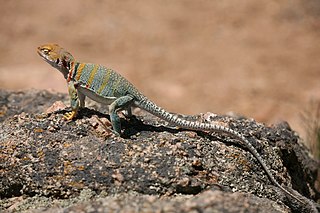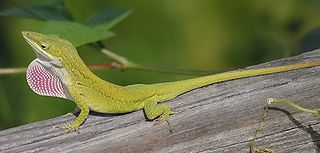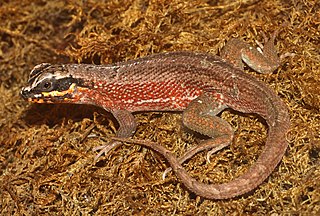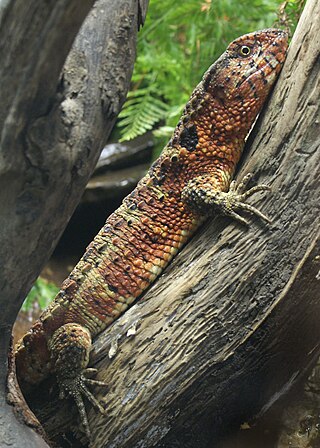
Squamata is the largest order of reptiles, comprising lizards and snakes. With over 11,500 species, it is also the second-largest order of extant (living) vertebrates, after the perciform fish. Members of the order are distinguished by their skins, which bear horny scales or shields, and must periodically engage in molting. They also possess movable quadrate bones, making possible movement of the upper jaw relative to the neurocranium. This is particularly visible in snakes, which are able to open their mouths very wide to accommodate comparatively large prey. Squamates are the most variably sized living reptiles, ranging from the 16 mm (0.63 in) dwarf gecko to the 6.5 m (21 ft) reticulated python. The now-extinct mosasaurs reached lengths over 14 m (46 ft).

The Crotaphytidae, or collared lizards, are a family of desert-dwelling reptiles native to the Southwestern United States and northern Mexico. Alternatively they are recognized as a subfamily, Crotaphytinae, within the clade Pleurodonta. They are very fast-moving animals, with long limbs and tails; some species are capable of achieving bipedal running at top speed. This species is carnivorous, feeding mainly on insects and smaller lizards. The two genera contain 12 species.

Hoplocercidae are a family of lizards native to the tropical forests, woodlands and savanna-like habitats of Central and South America. Alternatively they are recognized as a subfamily, Hoplocercinae. 20 species in three genera are described.

Dactyloidae are a family of lizards commonly known as anoles and native to warmer parts of the Americas, ranging from southeastern United States to Paraguay. Instead of treating it as a family, some authorities prefer to treat it as a subfamily, Dactyloinae, of the family Iguanidae. In the past they were included in the family Polychrotidae together with Polychrus, but the latter genus is not closely related to the true anoles.

The Iguanidae is a family of lizards composed of the iguanas, chuckwallas, and their prehistoric relatives, including the widespread green iguana.

Anolis is a genus of anoles, iguanian lizards in the family Dactyloidae, native to the Americas. With more than 425 species, it represents the world's most species-rich amniote tetrapod genus, although many of these have been proposed to be moved to other genera, in which case only about 45 Anolis species remain. Previously, it was classified under the family Polychrotidae that contained all the anoles, as well as Polychrus, but recent studies place it in the Dactyloidae.

The brown anole, also known commonly as the Cuban brown anole, or De la Sagra's anole, is a species of lizard in the family Dactyloidae. The species is native to Cuba and the Bahamas. It has been widely introduced elsewhere, via the importation and exportation of plants where the anole would lay eggs in the soil of the pots, and is now found in Florida and as far north in the United States as southern Georgia, Texas, Louisiana, Tennessee, Mississippi, Alabama, Hawaii, and Southern California. It has also been introduced to other Caribbean islands, Mexico, and Taiwan.

The Caenophidia are a derived clade of alethinophidian snakes, which contains over 80% of all the extant species of snakes. The largest family is Colubridae, but it also includes at least seven other families, at least four of which were once classified as "Colubridae" before molecular phylogenetics helped us understand their relationships. It has been found to be monophyletic.

Iguania is an infraorder of squamate reptiles that includes iguanas, chameleons, agamids, and New World lizards like anoles and phrynosomatids. Using morphological features as a guide to evolutionary relationships, the Iguania are believed to form the sister group to the remainder of the Squamata, which comprise nearly 11,000 named species, roughly 2000 of which are iguanians. However, molecular information has placed Iguania well within the Squamata as sister taxa to the Anguimorpha and closely related to snakes. The order has been under debate and revisions after being classified by Charles Lewis Camp in 1923 due to difficulties finding adequate synapomorphic morphological characteristics. Most Iguanias are arboreal but there are several terrestrial groups. They usually have primitive fleshy, non-prehensile tongues, although the tongue is highly modified in chameleons. The group has a fossil record that extends back to the Early Jurassic. Today they are scattered occurring in Madagascar, the Fiji and Friendly Islands and Western Hemisphere.

Anolis barbatus is a species of anole lizard from Western Cuba. Adults have a typical snout–vent length of about 18 cm (7 in), with tails that are slightly shorter than their bodies, and demonstrate little sexual dimorphism. It is one of six species called "false chameleons" that sometimes are recognized as their own genus Chamaeleolis or as the Cuban clade in Xiphosurus. These are all native to Cuba, fairly large for anoles, have robust heads, are dull gray-brown in color, slow-moving and have blunt teeth used for crushing snails, which is their main diet in the wild. Unusually among anoles, these all lack the ability to autotomize their tails. Together with the similar, but not closely related A. landestoyi of Hispaniola, they form a group known as the twig–giant ecomorph.

Anolis planiceps, commonly known as the golden-scaled anole, orange-fanned leaf-litter anole, or goldenscale anole, is a species of lizard in the family Dactyloidae. The species is found in Venezuela, Guyana, Brazil, and Trinidad.

Anolis poncensis is a species of lizard of the family of Dactyloidae. The species is endemic to Puerto Rico. It was first identified in Ponce, in the hills three miles east of the city. The Puerto Rico Department of Natural and Environmental Resources considers it a "vulnerable species".

Acrodonta are a subclade of iguanian squamates consisting almost entirely of Old World taxa. Extant representation include the families Chamaeleonidae (chameleons) and Agamidae, with at least over 500 species described. A fossil genus, Gueragama, was found in Brazil, making it the only known American representative of the group.

Neoanguimorpha is a clade of anguimorphs comprising Monstersauria and Diploglossa. Morphological studies in the past had classified helodermatids with the varanoids in the clade Platynota, while the Chinese crocodile lizard was classified as a xenosaurid. However molecular work found no support in these groupings and instead has found the helodermatids more related to Diploglossa, while the Chinese crocodile lizard and varanoids to form the clade Paleoanguimorpha.

Paleoanguimorpha is a clade of anguimorphs comprising Shinisauria and Goannasauria. Morphological studies in the past also classified helodermatids and pythonomorphs with the varanoids in the clade Platynota, while the Chinese crocodile lizard was classified as a xenosaurid. Current molecular work finds no support in these groupings and instead has found the helodermatids more related to Diploglossa in the sister clade Neoanguimorpha, while the Chinese crocodile lizard is the closet living relative to varanoids. Pythonomorphs represented by snakes today are not closely related to varanoids and are instead a sister lineage to Anguimorpha and Iguania in the clade Toxicofera.

Afrophidia is a clade of alethinophidian snakes comprising the groups Henophidia and Caenophidia, essentially making up the snakes people commonly associate with. The name refers to the deep split between Afrophidia and their sister taxon, Amerophidia, which originated in South American origin, and the afrophidians was recently hypothesized to represent a vicariant event of the breakup of Gondwanan South America and Africa.

Anolis apletophallus is a species of anoles, iguanian lizards in the family Dactyloidae native to Panama. The species was split from Anolis limifrons in Köhler and Sunyer (2008). It has been reported in Panama, Honduras and Colombia. A decline in its population in Panama over a 40-year timespan has been attributed to changes in local climate, with years following El Niño negatively affecting the species.

Anolis aquaticus, commonly known as the water anole, is a semi-aquatic species of anole, a lizard in the family Dactyloidae, native to southwestern Costa Rica and far southwestern Panama. The species demonstrates adaptations that allows it to spend periods of time underwater up to approximately a quarter of an hour, forming an air bubble which clings to its head and serves to recycle the animal's air supply while it spends time beneath the surface. Although highly unusual, similar adaptions and behavior are found in other species of semi-aquatic anoles.
Anolis charlesmyersi is a species of lizard in the family Dactyloidae. The species is native to Central America.

Anolis crassulus, the ornate anole, is a species of lizard in the family Dactyloidae. The species is found in Guatemala, El Salvador, and Mexico. This species is characterized by its moderately to strongly enlarged medial dorsal scales, no more than two scales separating the supraorbital semicircles, four to seven rows of loreals, suboculars and supralabials in contact under the central portion of the orbit, enlarged postanals in males, and heterogeneous flank squamation.



















